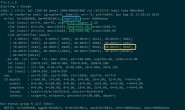C# 内置队列类Queue使用范例,本范例详细演示了C#内置的队列如何进行添加,移除等功能。
来自微软MSDN
using System;
using System.Collections.Generic;
class Example
{
public static void Main()
{
Queue<string> numbers = new Queue<string>();
numbers.Enqueue("one");
numbers.Enqueue("two");
numbers.Enqueue("three");
numbers.Enqueue("four");
numbers.Enqueue("five");
// A queue can be enumerated without disturbing its contents.
foreach( string number in numbers )
{
Console.WriteLine(number);
}
Console.WriteLine("\nDequeuing '{0}'", numbers.Dequeue());
Console.WriteLine("Peek at next item to dequeue: {0}",
numbers.Peek());
Console.WriteLine("Dequeuing '{0}'", numbers.Dequeue());
// Create a copy of the queue, using the ToArray method and the
// constructor that accepts an IEnumerable<T>.
Queue<string> queueCopy = new Queue<string>(numbers.ToArray());
Console.WriteLine("\nContents of the first copy:");
foreach( string number in queueCopy )
{
Console.WriteLine(number);
}
// Create an array twice the size of the queue and copy the
// elements of the queue, starting at the middle of the
// array.
string[] array2 = new string[numbers.Count * 2];
numbers.CopyTo(array2, numbers.Count);
// Create a second queue, using the constructor that accepts an
// IEnumerable(Of T).
Queue<string> queueCopy2 = new Queue<string>(array2);
Console.WriteLine("\nContents of the second copy, with duplicates and nulls:");
foreach( string number in queueCopy2 )
{
Console.WriteLine(number);
}
Console.WriteLine("\nqueueCopy.Contains(\"four\") = {0}",
queueCopy.Contains("four"));
Console.WriteLine("\nqueueCopy.Clear()");
queueCopy.Clear();
Console.WriteLine("\nqueueCopy.Count = {0}", queueCopy.Count);
}
}
/* This code example produces the following output:
one
two
three
four
five
Dequeuing 'one'
Peek at next item to dequeue: two
Dequeuing 'two'
Contents of the copy:
three
four
five
Contents of the second copy, with duplicates and nulls:
three
four
five
queueCopy.Contains("four") = True
queueCopy.Clear()
queueCopy.Count = 0
*/




